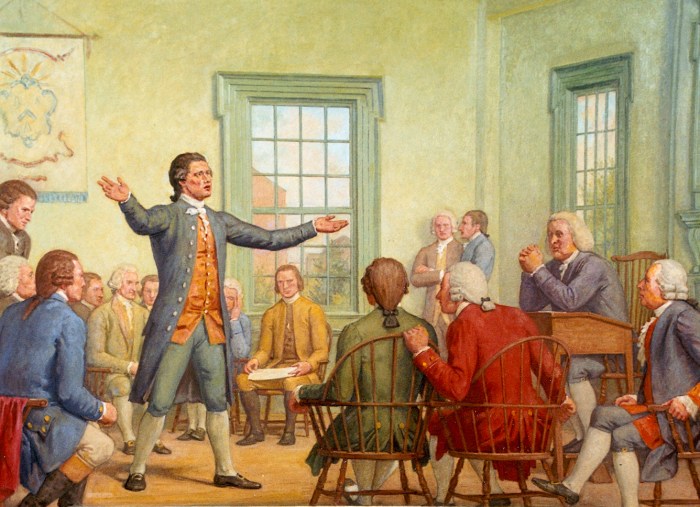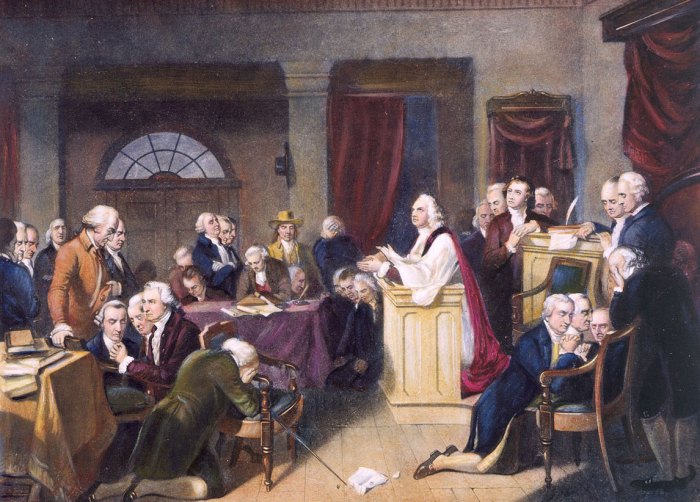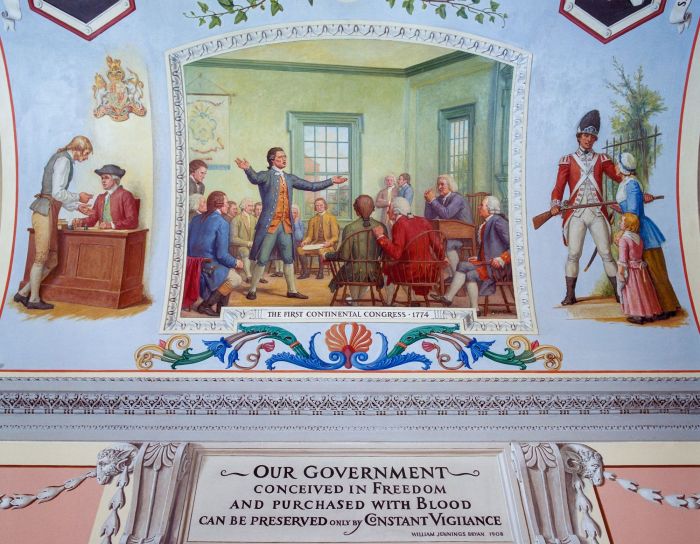The First Continental Congress, a gathering of colonial delegates in 1774, marked a pivotal moment in American history. It was a response to the escalating tensions between the colonies and Great Britain, fueled by a series of oppressive policies that ignited a firestorm of discontent.
From the Stamp Act to the Intolerable Acts, the colonists felt their rights and freedoms were under attack, leading them to seek a united front against the British crown.
This assembly, held in Philadelphia, Pennsylvania, brought together representatives from twelve of the thirteen colonies (Georgia was absent). These delegates, united by a shared sense of grievance, debated the course of action they would take to address the injustices imposed by the British government.
The First Continental Congress was a testament to the growing spirit of independence among the colonists, setting the stage for the momentous events that would follow.
Background of the First Continental Congress

The First Continental Congress, convened in Philadelphia in 1774, was a pivotal moment in the burgeoning American Revolution. It was the culmination of years of simmering discontent between the American colonies and the British government. This discontent stemmed from a series of British policies that the colonists perceived as unjust and oppressive.
British Policies and Colonial Unrest
The years leading up to the First Continental Congress were marked by increasing tensions between Britain and its American colonies. A series of British policies, aimed at asserting greater control over the colonies and raising revenue, fueled colonial resentment.
- The Stamp Act (1765):This act imposed a tax on all printed materials in the colonies, including newspapers, legal documents, and playing cards. The colonists viewed this as an infringement on their rights and a blatant attempt to raise revenue without their consent.
The cry of “No taxation without representation!” became a rallying cry for the colonists.
- The Townshend Acts (1767):These acts imposed taxes on goods imported from Britain, such as tea, glass, and paper. The colonists saw this as another attempt to raise revenue without their consent and responded with boycotts and protests.
- The Tea Act (1773):This act granted the British East India Company a monopoly on tea sales in the colonies, effectively eliminating competition from colonial merchants. The colonists saw this as a blatant attempt to undermine their economic interests and a move towards a more centralized, authoritarian system.
- The Intolerable Acts (1774):These acts were a series of punitive measures passed by the British Parliament in response to the Boston Tea Party. They closed the port of Boston, revoked the Massachusetts Charter, and allowed for the quartering of British troops in colonial homes.
These acts were widely seen as an assault on colonial liberties and fueled calls for independence.
Colonial Grievances
The British policies described above were a major source of colonial grievances. The colonists felt that they were being treated as second-class citizens and that their rights were being violated. They were particularly outraged by the lack of representation in the British Parliament, which was imposing taxes on them without their consent.
- Lack of Representation:The colonists argued that they should have the same rights as British citizens, including representation in Parliament. They argued that they were being taxed without representation, which violated their fundamental rights.
- Economic Restrictions:The colonists were also frustrated by the British government’s attempts to control their economic activities. They believed that they should be free to trade with other countries and that they should not be subject to unfair taxes and regulations.
- Military Presence:The colonists resented the presence of British troops in their midst, which they saw as a sign of distrust and a threat to their liberties. They were also outraged by the quartering of British troops in colonial homes, which they viewed as an infringement on their privacy and property rights.
Key Figures and their Roles
The First Continental Congress was a gathering of delegates from twelve of the thirteen colonies. It was a significant step toward colonial unity and independence.
- John Adams (Massachusetts):Adams was a prominent lawyer and political leader who played a key role in shaping the Congress’s agenda. He was a strong advocate for colonial rights and a vocal critic of British policies.
- George Washington (Virginia):Washington, a military leader and planter, was a delegate to the Congress and later served as the commander-in-chief of the Continental Army during the American Revolution.
- Thomas Jefferson (Virginia):Jefferson, a lawyer and political theorist, was not a delegate to the First Continental Congress but he was a strong supporter of colonial rights and independence.
- Patrick Henry (Virginia):Henry was a lawyer and orator who delivered a stirring speech at the Virginia Convention in 1775, urging the colonists to take up arms against the British.
- Samuel Adams (Massachusetts):Adams was a leading figure in the Sons of Liberty, a group of colonists who organized protests against British policies. He was a strong advocate for colonial rights and a vocal critic of British policies.
Key Decisions and Actions of the Congress
The First Continental Congress, a gathering of delegates from 12 of the 13 British colonies in North America, convened in Philadelphia in September 1774. It aimed to address the growing tensions with Great Britain and to find a solution to the escalating disputes over colonial rights and liberties.The Congress was a significant step towards independence, as it marked the first time that representatives from the colonies met to discuss a unified response to British policies.
The Congress adopted a series of resolutions and declarations that reflected the colonies’ grievances and their determination to resist British oppression.
Declaration of Rights and Grievances
The Congress issued a Declaration of Rights and Grievances, which Artikeld the colonists’ fundamental rights and freedoms. This document asserted the right to life, liberty, and property, and it condemned British policies that violated these rights. The Declaration argued that Parliament had no right to tax the colonies without their consent, and it called for the repeal of the Intolerable Acts, a series of repressive measures passed by the British Parliament.
Continental Association, First continental congress
To demonstrate their resolve and to exert economic pressure on Great Britain, the Congress established the Continental Association. This agreement called for a boycott of British goods and a non-importation agreement, which aimed to disrupt trade and force the British government to address the colonists’ demands.
The Continental Association was a significant step towards economic independence and it helped to unify the colonies in their opposition to British rule.
Petitions to the King
The Congress also sent petitions to King George III, seeking redress of the colonies’ grievances. These petitions reiterated the colonists’ loyalty to the British crown, but they also insisted on their rights as British subjects. The petitions were ultimately unsuccessful, as King George III refused to acknowledge the colonists’ demands.
The First Continental Congress and the Road to Revolution
The First Continental Congress, convened in 1774, marked a pivotal moment in the escalating tensions between the American colonies and Great Britain. While initially seeking to address grievances and achieve reconciliation, the Congress inadvertently fueled the flames of revolution through its actions and pronouncements.
The Congress served as a catalyst, uniting the colonies and fostering a shared sense of identity and purpose.
The Congress’s Role in Shaping Sentiment for Independence
The First Continental Congress played a crucial role in shaping the growing sentiment for independence among the American colonists. The delegates, representing twelve of the thirteen colonies (Georgia was absent), arrived in Philadelphia with a diverse range of views on the path forward.
While some favored a more conciliatory approach, others were increasingly convinced that independence was the only viable solution. The Congress’s Declaration of Rights and Grievances, a document that Artikeld the colonists’ grievances against British policies, served as a powerful rallying cry for unity and resistance.
The document condemned the Intolerable Acts, which were a series of punitive measures imposed by the British Parliament in response to the Boston Tea Party. The Declaration also asserted the colonists’ rights to self-governance and taxation by their own representatives.
By articulating a unified set of grievances, the Congress effectively consolidated colonial opposition to British rule and galvanized support for the cause of liberty.The Congress also adopted a series of resolutions that further strengthened the sentiment for independence. These resolutions included a boycott of British goods, a call for the formation of colonial militias, and a declaration that the colonies would not submit to the authority of the British Parliament until their grievances were addressed.
These measures demonstrated the colonists’ determination to resist British tyranny and their willingness to take a stand for their rights.
The Congress’s Decisions and the Escalation of Tensions
The decisions of the First Continental Congress contributed to the escalating tensions that led to the American Revolution. The Congress’s call for a boycott of British goods, for example, had a significant impact on the British economy. The boycott also served to further alienate the colonists from the British government, as it demonstrated their willingness to sacrifice for the cause of liberty.The Congress’s decision to form colonial militias also escalated tensions with Great Britain.
The militias were intended to provide a means of defense against potential British military action. However, their formation was seen by the British government as a direct challenge to its authority. The presence of armed militias in the colonies also served to heighten the sense of fear and paranoia among the colonists, as they anticipated a possible military confrontation with Great Britain.The Congress’s declaration that the colonies would not submit to the authority of the British Parliament until their grievances were addressed further strained relations between the colonies and Great Britain.
This declaration was seen as a direct act of defiance by the British government, and it served to further solidify the colonists’ commitment to independence.
Views of the Delegates Regarding Independence
The delegates to the First Continental Congress held a range of views regarding independence and the path forward. While some delegates, such as John Adams and Thomas Jefferson, were outspoken advocates for independence, others, such as John Dickinson, were more hesitant to sever ties with Great Britain.Those who favored independence argued that the colonies had been subjected to years of British oppression and that the only way to secure their rights was to declare their independence.
They believed that the British government was unwilling to address the colonists’ grievances and that the only way to achieve liberty was to break free from British rule.Those who were hesitant to declare independence argued that the colonies were economically and militarily dependent on Great Britain and that independence would lead to chaos and instability.
They believed that the colonies could achieve their goals through negotiation and compromise with the British government.The First Continental Congress did not declare independence, but it did lay the groundwork for the revolution that would follow. The Congress’s actions and pronouncements served to unite the colonies, raise the colonists’ awareness of their rights, and prepare them for the struggle for independence.
Legacy of the First Continental Congress
The First Continental Congress, convened in 1774, marked a pivotal moment in American history. It not only addressed the immediate grievances with British rule but also laid the groundwork for the American Revolution and the formation of the United States.
The Congress’s decisions and actions had a lasting impact, shaping the course of American politics, society, and government for generations to come.
Long-Term Impact on American History
The First Continental Congress served as a catalyst for the American Revolution, uniting the colonies in their opposition to British policies. It established a framework for colonial cooperation and resistance, setting the stage for the Second Continental Congress, which would ultimately declare independence.
The Congress’s actions also fostered a sense of national identity and unity among the colonists, paving the way for the creation of a unified nation.
The First Continental Congress, a pivotal moment in American history, saw delegates from 12 colonies gather to address grievances against British rule. While the delegates debated the path forward, artists were already envisioning a new future. Take a look at the concord concept art for a glimpse into the spirit of innovation and progress that fueled the American Revolution.
This artistic expression, much like the Congress’s resolutions, reflected a desire for self-governance and a bold vision for the future of the colonies.
Concord, Massachusetts
The sleepy town of Concord, Massachusetts, became a pivotal site in the American Revolution on April 19, 1775. The events that unfolded that day, known as the “Battle of Lexington and Concord,” marked the beginning of a bloody conflict that would ultimately lead to the birth of a new nation.
The Events of April 19, 1775
On that fateful day, a British force, led by Lieutenant Colonel Francis Smith, set out from Boston on a mission to seize colonial military supplies stored in Concord. Their journey, however, was not a secret. Word had spread through the colonial network of riders, known as the “Minutemen,” that the British were on the move.
As the British approached Lexington, they encountered a small contingent of colonial militia, who were outnumbered and outgunned. The ensuing skirmish, known as the “Battle of Lexington,” resulted in the deaths of eight colonists and only one British soldier.
After Lexington, the British continued their march toward Concord, where they found the colonial militia had already moved the supplies. The British, frustrated and angered, began to destroy what remained. However, the colonists, alerted by the ringing of church bells, quickly mobilized and engaged the British in a series of skirmishes throughout Concord.
The British, now facing a growing resistance, retreated back toward Boston, pursued by the colonists all the way.
The Significance of the Battle of Lexington and Concord
The “Battle of Lexington and Concord” was a turning point in the American Revolution. It marked the first shots fired in the conflict, and it galvanized colonial resistance. The events of that day showed that the colonists were willing to fight for their freedom, and they instilled a sense of unity and purpose among the colonies.
The battles also demonstrated the effectiveness of colonial militia tactics, which relied on hit-and-run attacks and guerilla warfare.
The Impact of the Events in Concord on the Development of Colonial Resistance
The events in Concord had a profound impact on the development of colonial resistance. The battles inspired colonists to take up arms and join the fight for independence. They also led to the formation of the Continental Army, under the leadership of General George Washington, which would become the primary fighting force of the Revolution.
Furthermore, the events in Concord helped to solidify the colonial resolve to break free from British rule. The colonists realized that they were fighting for a cause greater than themselves, and they were willing to sacrifice their lives for the sake of liberty.
The Concord: A Symbol of American Independence

Concord, Massachusetts, is a small town that played a pivotal role in the American Revolution. The events that unfolded there on April 19, 1775, became a symbol of American defiance against British tyranny, inspiring the colonists to fight for their freedom.
The town’s historical significance goes beyond its role in the Revolution, and its rich history continues to resonate with generations of Americans.
Historical Significance of Concord
Concord’s historical significance lies in its role as a focal point of the American Revolution. It was here that the first shots of the war were fired, marking the beginning of a long and arduous struggle for independence. The town’s residents, armed with muskets and determination, stood their ground against the British Regulars, demonstrating their unwavering commitment to liberty.
This act of defiance, known as the “Battle of Lexington and Concord,” served as a rallying cry for the colonists throughout the thirteen colonies, galvanizing them to unite against British oppression. The events of that day forever etched Concord’s name in the annals of American history, solidifying its place as a symbol of American independence.
Timeline of Key Events in Concord
The events leading up to the American Revolution in Concord, Massachusetts, were a culmination of growing tensions between the colonists and the British government. This timeline highlights key events that shaped the town’s role in the Revolution.
- 1774:The First Continental Congress convenes in Philadelphia, Pennsylvania, to address colonial grievances against British policies. Representatives from twelve of the thirteen colonies, excluding Georgia, gather to discuss a unified response to British actions. The Congress issues a Declaration of Rights and Grievances, demanding the repeal of oppressive laws and asserting colonial rights.
- April 18, 1775:The British Army, under the command of Lieutenant Colonel Francis Smith, sets out from Boston to seize colonial military supplies stored in Concord. The colonists, alerted to the British advance, prepare for a confrontation.
- April 19, 1775:The British troops reach Lexington, Massachusetts, where they encounter a small contingent of colonial militia. The ensuing confrontation, known as the “Battle of Lexington,” marks the first shots of the American Revolution. The British troops then proceed to Concord, where they encounter heavy resistance from the colonial militia.
The “Battle of Concord” ensues, resulting in significant casualties on both sides.
- April 20, 1775:The British troops, facing relentless pursuit by the colonial militia, retreat back to Boston. This retreat, known as the “British Retreat from Concord,” becomes a pivotal moment in the Revolution, as the colonists demonstrate their determination to resist British tyranny.
- May 10, 1775:The Second Continental Congress convenes in Philadelphia, Pennsylvania, to address the escalating conflict with Britain. The Congress establishes the Continental Army, with George Washington appointed as its commander-in-chief. This marked a significant step towards the formation of a unified colonial government and army.
The Battle of Lexington and Concord
The Battle of Lexington and Concord was a pivotal event in the American Revolution. It marked the first open confrontation between British troops and colonial militia, signifying the start of a long and arduous struggle for independence. The battle unfolded on April 19, 1775, in the towns of Lexington and Concord, Massachusetts.The British troops, under the command of Lieutenant Colonel Francis Smith, set out from Boston to seize colonial military supplies stored in Concord.
The colonists, alerted to the British advance, prepared for a confrontation. The British troops reached Lexington, where they encountered a small contingent of colonial militia. The ensuing confrontation, known as the “Battle of Lexington,” resulted in the deaths of eight colonists and one British soldier.
The British troops then proceeded to Concord, where they encountered heavy resistance from the colonial militia. The “Battle of Concord” ensued, resulting in significant casualties on both sides.The British troops, facing relentless pursuit by the colonial militia, retreated back to Boston.
This retreat, known as the “British Retreat from Concord,” became a pivotal moment in the Revolution, as the colonists demonstrated their determination to resist British tyranny. The Battle of Lexington and Concord, while relatively small in scale, had a profound impact on the course of the American Revolution.
It served as a rallying cry for the colonists throughout the thirteen colonies, galvanizing them to unite against British oppression. The events of that day forever etched Concord’s name in the annals of American history, solidifying its place as a symbol of American independence.
Ultimate Conclusion

The First Continental Congress was more than just a meeting; it was a turning point in the relationship between the colonies and Great Britain. The delegates’ decisions, their declarations of colonial rights, and their calls for boycotts sent a clear message to the British government: the colonies were no longer willing to tolerate the oppressive policies.
The Congress, in essence, solidified the colonial resistance, laying the foundation for the American Revolution that would erupt the following year. The legacy of the First Continental Congress lives on, reminding us of the power of collective action and the enduring spirit of freedom that continues to shape America’s identity.






